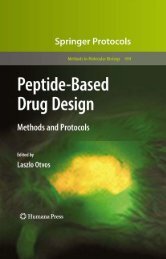Create successful ePaper yourself
Turn your PDF publications into a flip-book with our unique Google optimized e-Paper software.
248 Chua et al.<br />
vaccines, including peptide epitope-based vaccines, is the weak immunogenicity<br />
that they display in the absence of adjuvant. Although many experimental<br />
adjuvants are available, only oil-in-water emulsions, aluminum-based<br />
salt adjuvants, and virosomes are currently licensed for use in humans, while<br />
surfactant-based and microbial-derived formulations are presently still at the<br />
stage of preclinical and clinical trial testing (19,20).<br />
An effective way to enhance the immunogenicity of peptide epitopes is<br />
to incorporate lipid groups that have self-adjuvanting properties into the<br />
peptide structure. Of particular interest to many groups are palmitic acid–based<br />
adjuvants ranging from palmitic acid itself (21,22) to the somewhat more sophisticated<br />
derivatives dipalmitoyl-S-glyceryl cysteine (Pam2Cys) (1,4,23–25) and<br />
tripalmitoyl-S-glyceryl cysteine (Pam3Cys) (26–28). These simple lipid moieties<br />
have been shown to be effective in adjuvanting epitope-based vaccines and,<br />
importantly, do not exhibit the harmful side effects commonly associated with<br />
many other adjuvant formulations (29).<br />
Lipopeptides bearing Pam2Cys in particular have been shown to be able<br />
to induce effective Th1- and Th2-type immune responses as demonstrated by<br />
the generation of both short- and long-term protective cytotoxic T lymphocytes<br />
and induction of antibody. Pam2Cys is a synthetic analogue of MALP-2<br />
(macrophage-activating lipopeptide-2) derived from the cytoplasmic membrane<br />
of Mycoplasma fermentans (24). The potent immunogenicity of lipopeptides<br />
bearing Pam2Cys can be explained by their ability to activate dendritic cells<br />
(4,23,25), key cells that are responsible for initiating immune responses. This<br />
event occurs through a mechanism consistent with signal transduction via Tolllike<br />
receptor-2 (TLR-2) (4), one of many receptors involved in the first line of<br />
host defense against pathogenic threats.<br />
This chapter describes in detail the techniques involved in the synthesis of a<br />
Pam2Cys-based lipopeptide vaccine that can induce the production of specific<br />
antibodies in vaccinated mice. As an example, we have used the sequence for<br />
luteinizing hormone-releasing hormone (LHRH) as the target antigen, but this<br />
can be substituted with other B-cell epitopes depending on the requirements of<br />
the investigator. LHRH is a 10-amino-acid peptide hormone that is secreted by<br />
the hypothalamus to initiate a cascade of events that regulates gametogenesis and<br />
reproductive function. It does this by stimulating the synthesis and secretion of<br />
follicle-stimulating hormone and luteinizing hormone from the anterior pituitary<br />
(30). The LHRH sequence is an ideal immunocontraceptive target because its<br />
sequence, HWSYGLRPG, is conserved in all mammals. Such a vaccine could<br />
be of benefit as an alternative to surgical castration in companion animals and<br />
particularly in the livestock industry (31). Although its use in humans is limited<br />
because of the behavioral problems associated with the suppression of sex<br />
hormone production, it may nonetheless still prove useful as a supplementary<br />
treatment for the control of hormone-dependent malignancies (32,33).






